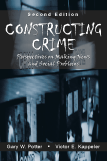Part I. MAKING NEWS
1. Enter Moral Panics (Erich Goode and Nachman Ben-Yehuda)
2. Media Constructions of Crime (Vincent F. Sacco)
3. Crime Waves as Ideology (Mark Fishman)
4. Fear and Loathing on Reality Television: An Analysis of America’s Most Wanted and Unsolved Mysteries (Gary Cavender and Lisa Bond-Maupin)
5. State Managers, Intellectuals, and the Media: A Content Analysis of Ideology in Experts’ Quotes in Feature Newspaper Articles on Crime (Michael Welch, Melissa Fenwick, and Meredith Roberts)
Part II. CONSTRUCTING CRIME PROBLEMS
6. The Gang Initiation Rite as a Motif in Contemporary Crime Discourse (Joel Best and Mary M. Hutchinson)
7. The Presentation of Drugs in the News Media: The News Sources Involved in the Construction of Social Problems (Steven Chermak)
8. The Social Construction of an Alcohol Problem: The Case of Mothers against Drunk Drivers and Social Control in the 1980s (Craig Reinarman)
9. Coverage of Domestic Violence Fatalities by Newspapers in Washington State (Cathy Ferrand Bullock and Jason Cubert)
10. The Media Construction of Stalking Stereotypes (Brian H. Spitzberg and Michelle Cadiz)
11. The Role of Television News in the Construction of School Violence as a “Moral Panic” (Donna Killingbeck)
12. Constructing “Crime”: Media Coverage of Individual and Organizational Wrongdoing (William S. Lofquist)
13. “Road Warriors” on “Hair-Trigger Highways”: Cultural Resources and the Media’s Construction of the 1987 Freeway Shootings Problem (Joel Best)
Part III. EFFECTS OF CONSTRUCTING CRIME
14. Crime, News and Fear of Crime: Toward an Identification of Audience Effects (Ted Chiricos, Sarah Eschholz, and Marc Gertz)
15. Perceived Fears: The Reporting Patterns of Juvenile Homicide in Chicago Newspapers (John G. Boulahanis and Martha J. Heltsley)
16. “All the News That’s Fit to Print”: A Content Analysis of the Correctional Debate in the New York Times (Michael Welch, Lisa Weber, and Walter Edwards)
17. Dominant Ideology and Drugs in the Media (Craig Reinarman and Ceres Duskin)
18. Breaking News: How Local TV News and Real-World Conditions Affect Fear of Crime (Ronald Weitzer and Charis E. Kubrin)

392 pages, $44.95 list
1-57766-446-9
978-1-57766-446-8
© 2006
paperback
Constructing Crime
Perspectives on Making News and Social Problems
Second Edition
This intriguing collection of articles explores the many actors, practices, and techniques involved in constructing the social reality of crime. The first section offers an overview of the issues associated with studying crime and the media. The next section explores the making of crime problems from gang rituals to less mature constructions of crime like road warriors. The final section looks at the effects of media constructions of crime.
The frames through which crime is projected increase fear and shape perceptions of the amount of crime committed, the types of crime, who commits crimes, and what crimes are social problems. Sensational and violent crimes are featured prominently in the media, exaggerating the risks faced by the public and reinforcing stereotypes about who commits crime and why.
While the media are instrumental in defining the terms through which we think about crime, informed audiences can decide how to interpret crime news by asking questions such as: Who supplied the information? Do they have a vested interest in how we react? Who benefits from the presentation? Who is harmed? The articles in this collection provide roadmaps to navigate through filtered information to an informed analysis.
The frames through which crime is projected increase fear and shape perceptions of the amount of crime committed, the types of crime, who commits crimes, and what crimes are social problems. Sensational and violent crimes are featured prominently in the media, exaggerating the risks faced by the public and reinforcing stereotypes about who commits crime and why.
While the media are instrumental in defining the terms through which we think about crime, informed audiences can decide how to interpret crime news by asking questions such as: Who supplied the information? Do they have a vested interest in how we react? Who benefits from the presentation? Who is harmed? The articles in this collection provide roadmaps to navigate through filtered information to an informed analysis.